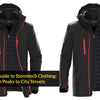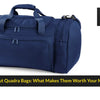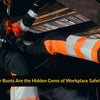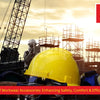When Should You Wear Protective Clothing?
- by Mike Johnson

When Should You Wear Protective Clothing?
There are several situations where it is advisable to wear protective clothing to protect yourself from potential risks. In addition, different types of apparel fulfil other functions and can help reduce the risk of injury.
The appropriate protective clothing will depend on the type of risks that you might encounter while working or playing. However, knowing what type of clothing is best for a given situation can be difficult.
There are two main categories of protective clothing: coveralls and workwear. In addition, these two types come with various sub-categories, such as long sleeve vs short sleeve, hooded vs non-hooded, synthetic vs natural fibre etc.
Depending on your workplace or activity, you’ll need to choose appropriately fitting gear and the suitable material for your needs. Keep reading for more information about choosing the right type of protective clothing for your needs.
Safety Footwear
Appropriate footwear is crucial whether you are on the job site, in the shop, working on your car, or doing any other type of heavy-duty work. Suitable footwear will protect your feet from debris, chemicals, and other harmful substances that may be present in your work environment.
Furthermore, it will also reduce the risk of a foot injury. Footwear designed for work can be found in many styles and materials, such as steel-toe boots, work boots, and safety shoes. This footwear will protect your feet from a wide range of hazards, from heavy objects that could fall on your feet to extreme heat or cold, depending on the specific type of footwear you select.
Protective Clothing
Protective clothing is designed to offer additional protection from various hazards. Many defensive clothing types include coveralls, workwear, welding jackets and pants, chemical protective clothing, and others.
The type of protective clothing you choose will depend on the hazards you are working with and the potential risks in your work environment. Depending on your needs, there are many available protective clothing options. For example, coveralls and workwear are two types of protective clothing. Coveralls are loose-fitting garments designed to be worn as the outer layer of clothing. In comparison, workwear is more tightly fitted, making it an ideal choice for situations where a looser-fitting garment would get in the way of your work.
Welding Shirts And Trousers
Welding shirts and pants protect your legs and lower body from spatter and sparks that may be released during welding. The fabric used in these garments is often a combination of cotton and synthetic materials designed to meet a wide range of needs.
In addition, these fabrics are treated with a polymer coating to help protect against sparks and spatter. For added protection, welding shirts and pants often include extra pockets; this allows you to store your welding tools and other accessories within easy reach. Furthermore, these garments are usually designed with a high-quality fabric that will resist the damage caused by sparks and spatter.
Depending on the type of welding that you will be doing, you will need to choose the appropriate welding shirt or trousers. For example, you may want to select a type of fabric resistant to iron spatter for welding iron. Similarly, you may want a type of welding shirt or trousers resistant to bronze spatter for welding bronze.
Protective Mask Or Helmet
A protective mask or helmet will provide additional protection from hazards in your work environment. These garments protect your head, face, eyes, and neck from potential risks. This can include falling objects, chemicals, extreme temperatures, and others.
A protective mask or helmet can be found in various materials, including different fabrics, synthetic materials, and metals. Depending on the hazards you are dealing with, you will need to choose the appropriate type of mask or helmet. For example, extreme sports often use a full-face helmet to protect against impact injuries.
Conclusion - When Should You Wear Protective Clothing?
Protective clothing is designed to protect you against a wide range of hazards. Several types of protective clothing include coveralls, workwear, welding jackets and pants, chemical protective clothing, and others.
Depending on the hazards you are dealing with, you will need to choose the appropriate type of clothing. The proper protective clothing will depend on the type of risks that you might encounter while working or playing.
However, knowing what type of clothing is best for a given situation can be difficult.
At Active Workwear, we are always happy to guide you through the best options for your specific work activity; give us a call: 0113 256 7021 or email: info@workwearshop.co.uk and we will be very happy to help.





